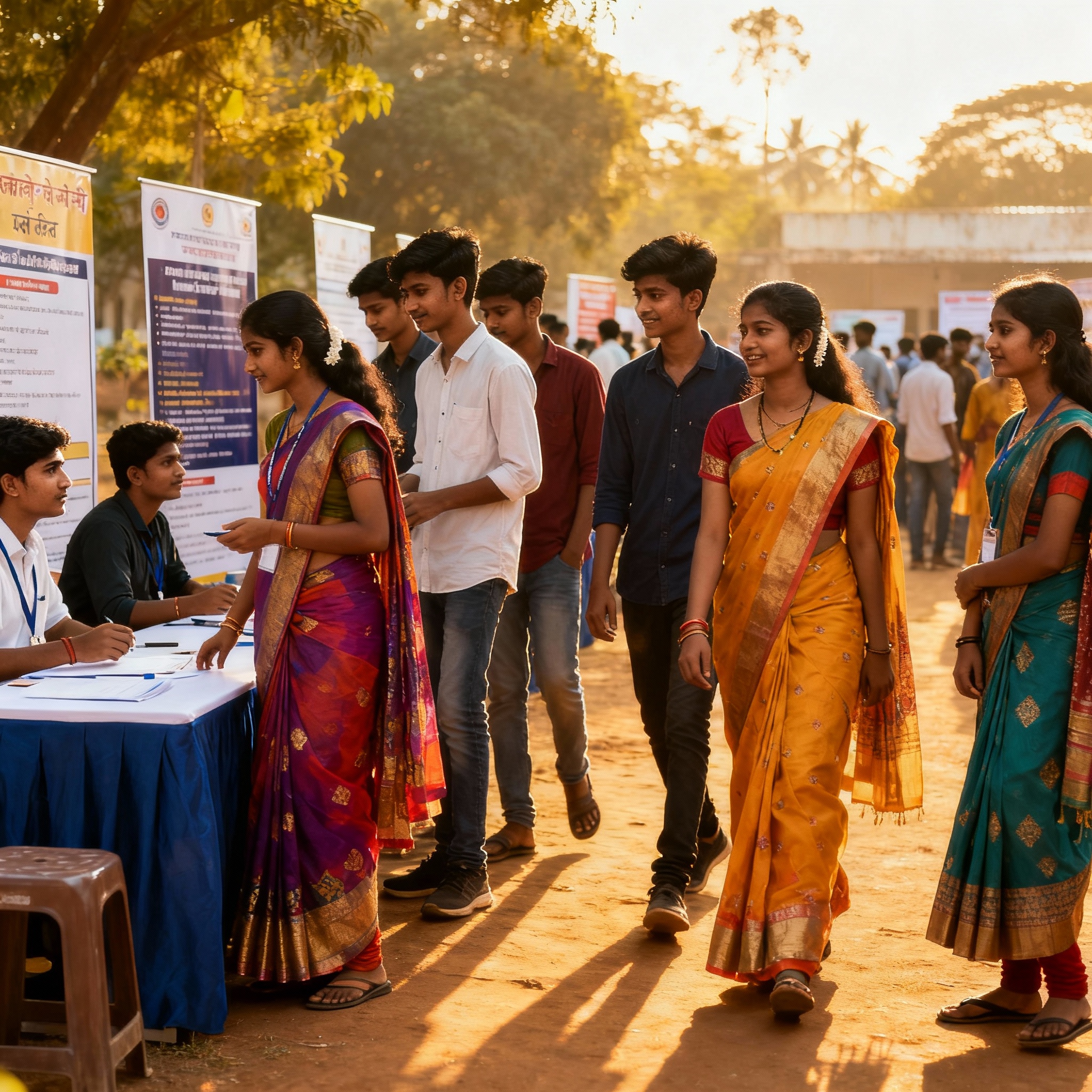Jobs and Employment Trends in Vijayapura

Introduction
Vijayapura district, a historic commercial and agricultural center in North Karnataka, is experiencing a period of economic transition that is reshaping its employment landscape. With a population of approximately 2.4 million (Census 2011), the district’s workforce is adapting to shifting opportunities across agriculture, manufacturing, services, and the informal economy. This article examines local job trends, youth employment challenges, skill development initiatives, migration patterns, and government schemes, drawing on verifiable data from official sources and credible news reports.
Employment Landscape and District Employment Exchange
The District Employment Exchange (DEE), Vijayapura, serves as the primary official portal for job registration and placement. As of the latest annual report (2023–24) from the Karnataka Department of Skill Development, Employment and Livelihood:
- Registered job seekers: Approximately 78,500 active registrants, a 9% rise from the previous year.
- Placements facilitated: Around 2,800 formal-sector placements in 2023–24, mainly in government departments, public sector undertakings, and selected private firms.
- Sectoral distribution of placements: 42% clerical/administrative; 28% technical/industrial; 18% teaching and health; 12% miscellaneous services.
While the DEE captures formal registrations, it is widely understood that a substantial share of Vijayapura’s workforce operates in the informal economy (agriculture, small trade, daily labor), which remains largely unrecorded in these statistics.
Key Employment Sectors
Based on data from the District Industries Centre (DIC), Vijayapura (2024) and the latest district economic census:
- Agriculture and allied sectors: Still the dominant employer, accounting for approximately 58–60% of the workforce (primarily farmers, agricultural laborers, and those in animal husbandry and horticulture).
- Manufacturing and industry: Around 12% of formal employment, concentrated in agro-processing, textile mills, sugar factories, and cement plants.
- Retail and wholesale trade: About 15%, including small merchants, APMC traders, and shopkeepers.
- Public administration, education, health: Approximately 8%, comprising government employees, teachers, and health workers.
- Construction and transport: About 7%, largely informal daily-wage work.
Youth Employment and the Job Crisis
Youth unemployment (ages 18–29) is a pressing concern in Vijayapura, as it is across much of rural Karnataka. According to the Deccan Herald’s analysis (June 2024) citing state employment data:
- Approximately 35% of registered job seekers in Vijayapura are aged 18–29.
- Educational qualification mismatch: Many youth hold undergraduate degrees (B.A., B.Com, B.Sc.) but lack the vocational or technical skills demanded by local industries.
- Limited private-sector jobs: The district’s industrial base is small relative to its population, forcing many educated youth to seek government jobs or migrate to Bangalore, Pune, or Mumbai for employment.
The Hindu reported (March 2024) that Vijayapura saw over 18,000 applicants for fewer than 300 government vacancies in a recent recruitment drive, underscoring the intense competition for stable, salaried positions.
Skill Development Initiatives
To bridge the gap between education and employability, the central and state governments have launched multiple skill development programs in Vijayapura:
Pradhan Mantri Kaushal Vikas Yojana (PMKVY) and Skill India
- Vijayapura hosts five Skill India-affiliated training centers, which have trained approximately 6,800 youth in 2023–24 (per Skill India Mission data).
- Key trades: Electrical technician, plumbing, retail management, automotive service, construction, IT/computer hardware, and hospitality.
- Placement rate: About 42% of PMKVY-trained candidates secured jobs or self-employment opportunities within six months of certification, according to the District Skill Development Officer.
Industrial Training Institutes (ITIs)
- Vijayapura has four government ITIs and several private ITI centers, offering diploma and certificate courses in trades such as fitter, electrician, welder, mechanic, and computer operator.
- Combined annual enrollment: ~2,200 students (2023–24).
- Partnerships with local industries (textile mills, cement plants, sugar factories) have improved internship and placement opportunities for ITI graduates.
Other Programs
- Karnataka Skill Connect and Udyogini: State schemes targeting youth and women, with training in entrepreneurship, tailoring, food processing, and digital literacy.
- DIC-run entrepreneurship development programs (EDPs): Over 400 participants in 2023–24, many of whom received support to start micro-enterprises.
Employment Fairs and Job Melas
The District Employment Exchange, in coordination with DIC and local industry associations, organizes quarterly job fairs (melas) in Vijayapura. In 2023–24, four major job fairs were held, attracting:
- Over 12,000 job seekers
- 85+ participating employers (including regional manufacturing firms, retail chains, hospitality groups, and government departments)
- Approximately 1,200 on-the-spot offers and interview call letters, as reported by The Hindu (September 2024).
These fairs are a critical bridge, particularly for semi-skilled and skilled workers, providing direct access to employers and reducing information asymmetry.
Migration Trends
Migration for employment is a longstanding pattern in Vijayapura. According to the Economic Survey of Karnataka (2023) and district-level studies:
- Seasonal migration: An estimated 25,000–30,000 workers migrate seasonally to sugarcane-harvesting regions in Maharashtra and to construction sites in Bangalore, Pune, and Hyderabad.
- Permanent migration: Young professionals, especially those with technical or higher education, often relocate to Bangalore, Pune, or Mumbai for IT, engineering, and service-sector roles.
- Return migration: During the COVID-19 pandemic, thousands of migrants returned to Vijayapura, placing additional pressure on local employment. Government schemes like MGNREGA (Mahatma Gandhi National Rural Employment Guarantee Act) absorbed some of this labor force temporarily.
Migration is driven by limited local opportunities, wage differentials, and the aspiration for stable, higher-paying jobs.
Government Schemes for Employment and Livelihood
Several central and state schemes aim to boost employment and livelihoods in Vijayapura:
- MGNREGA: Provides guaranteed wage employment for rural households. In 2023–24, Vijayapura generated approximately 3.8 million person-days of work under MGNREGA (per Ministry of Rural Development data).
- Prime Minister’s Employment Generation Programme (PMEGP): Supports micro-enterprise creation through subsidized credit. Around 320 new units were established in Vijayapura in 2023–24, per DIC records.
- Startup Karnataka and MSME schemes: Encourage entrepreneurship, particularly among youth and women, with access to training, credit, and market linkages.
- Karnataka State Rural Livelihoods Mission (KSRLM): Focuses on women’s self-help groups (SHGs), providing skill training, micro-credit, and market access. Vijayapura has over 8,500 active SHGs.
Challenges and Structural Barriers
- Slow industrial growth: Despite its strategic location, Vijayapura has not attracted large-scale manufacturing or IT investment, limiting formal job creation.
- Skill-job mismatch: Educational curricula often do not align with local industry needs, leaving graduates unemployed or underemployed.
- Infrastructure gaps: Inadequate transport, unreliable power, and limited digital connectivity deter business expansion and entrepreneurship.
- Social factors: Gender disparities persist—female labor force participation remains lower than the national average, particularly in formal sectors.
- Low wages in informal sectors: Daily wage workers in agriculture and construction earn below the poverty line in many cases, with no social security or employment benefits.
Opportunities and the Way Forward
- Agro-processing and value addition: With strong agricultural output (grapes, pomegranates, pulses), there is potential for food processing units, cold storage, and export-oriented businesses.
- Tourism and heritage: Vijayapura’s rich history (Gol Gumbaz, Ibrahim Rauza, Bara Kaman) can drive hospitality, guiding, and craft sectors.
- Digital economy: Improved internet access and digital literacy programs can enable freelancing, e-commerce, and remote work opportunities for youth.
- Strengthening ITIs and vocational training: Expanding capacity, updating curricula, and deepening industry partnerships will improve employability.
- Promoting entrepreneurship: More accessible credit, mentorship, and incubation support can help youth and women start their own enterprises.
Conclusion
Jobs and employment trends in Vijayapura reflect both the challenges of a transitioning economy and the resilience of its workforce. While agriculture remains the backbone, the district is slowly diversifying into manufacturing, services, and entrepreneurship. Youth unemployment, skill mismatches, and migration continue to be significant concerns, but initiatives like PMKVY, ITI expansion, job fairs, and government schemes offer pathways to progress. With sustained investment in infrastructure, education, skill development, and industrial growth, Vijayapura can unlock greater employment opportunities and improve livelihoods for its people.
Sources:
- Karnataka Department of Skill Development, Employment and Livelihood (2023–24 Annual Report)
- District Industries Centre (DIC), Vijayapura (2024)
- Skill India Mission – District-level Data (2024)
- Ministry of Rural Development – MGNREGA Data (2023–24)
- Economic Survey of Karnataka (2023)
- Deccan Herald – “Youth Unemployment Crisis in North Karnataka” (June 2024)
- The Hindu – “Job Fair Draws Thousands in Vijayapura” (September 2024); “Government Job Competition Surges” (March 2024)
- National Horticulture Board and Karnataka State Agricultural Marketing Board (employment and market data)



